![]()
Tue, Aug 23, 2011 | The Meir Amit Intelligence and Terrorism Information Center
Palestinian Terrorism: Portrait of the Popular Resistance Committees
The Popular Resistance Committees: Portrait of the Terrorist Organization Responsible for the Series of Combined Terrorist Attacks North of Eilat, Israel’s Southernmost City.
Overview
On August 18, 2011, beginning at noon, a terrorist organization operating from the Gaza Strip called the Popular Resistance Committees (PRC) carried out a series of combined terrorist attacks against a number of targets, among them a number of civilian vehicles. The attacks occurred north of the Netafim crossing, about 20 kilometers (12.4 miles) north of Eilat, (Israel’s southernmost city). In our assessment the terrorists came from the Gaza Strip. Eight Israelis were killed in the attacks and 30 were wounded. No organization publicly claimed responsibility, and the Popular Resistance Committees denied all connection to the terrorist attack (as they have done in similar cases in the past). However, the Israeli prime minister and other Israeli sources have indicated that the PRC was the organization which carried out the attack.
In response, the Israeli Air Force attacked a house in the southern Gaza Strip city of Rafah which served as a PRC command site where prominent members of the organization were gathered. Kamal al-Nairab (Abu Awad), commander of the PRC’s main Gaza Strip faction, and two other prominent PRC terrorists were killed in the attack. Also killed were two terrorist operatives from the organization’s military wing. Israeli Prime Minister Benjamin Netanyahu said that “those who gave the order to murder our citizens, while hiding in Gaza, are no longer among the living.”[1]
Following the Israeli response, the terrorist organizations operating in the Gaza Strip attacked Israeli population centers. They fired almost 160 rockets, of which about 120 fell in Israeli territory (as of August 22). The IDF retaliated by attacking terrorist targets in the Gaza Strip. The PRC participated in the rocket attacks, claiming responsibility for the dozens of attacks on Beersheba and other southern Israeli cities.[2] On August 22, Hamas and the PRC announced their acceptance of a lull in the fighting; however, even after the announcement several rockets were fired into Israeli territory.
The Popular Resistance Committees is a small terrorist organization with extensive operational capabilities. Several years ago it split into three factions, two of which collaborate with Hamas and in effect operate under its aegis. The third faction, called the Army of Islam, is affiliated with the global jihad, and carries out terrorist attacks independently, occasionally challenging Hamas and its restrained attack policy. Kamal al-Nairab and the other prominent terrorists killed in the Israeli Air Force attack on August 18 belonged to one of the PRC factions collaborating with Hamas.
An analysis of the PRC’s modus operandi indicates a preference attacking Israel through the route of the Sinai Peninsula. Such attacks were carried out by both the PRC and Hamas even before Operation Cast Lead, and to a greater extent after it. The organizations exploited the Egyptian government’s difficulty in enforcing law and order in the Sinai Peninsula (a situation which worsened after the fall of Mubarak) and were supported by a vast network of Bedouin collaborators living in Sinai.
Since Operation Cast Lead the importance of the indirect route through the Sinai Peninsula from the Gaza Strip to Israel has increased in the eyes of both Hamas and the PRC factions, the result of Hamas’ policy of restraint within the Gaza Strip, which has usually been enforced on the terrorist organizations operating there. In the two years since Operation Cast Lead the Sinai Peninsula has served as a highway for terrorist squads of both Hamas and the PRC planning to infiltrate Israel to carry out various types of attacks (mass-murders, abduction, penetration deep into Israeli territory and firing rockets at Eilat). However, the PRC, like Hamas, has never claimed responsibility for such attacks, fearing repercussions from the Egyptian authorities.[3]
This document examines the nature and modus operandi of the PRC factions and their relations with Hamas, as follows:
1) The establishment of the PRC and its split into factions.
2) The involvement of Hamas and the PRC in terrorist activities carried out from the Sinai Peninsula, 2009-2011.
3) Various types of terrorist attacks carried out by the PRC, 2009-2011.
4) Development of the PRC’s military capabilities since Operation Cast Lead.
5) PRC activity from the Gaza Strip before Operation Cast Lead.
6) PRC attempts to launch terrorist attacks against Israel from the Sinai Peninsula before Operation Cast Lead.
7) PRC cooperation with Hamas.
8) Participation of the Zakaria Dughmush faction in the Egyptian conference in support of the “option of resistance” [i.e., terrorism].
The Establishment of the PRC and its Split into Factions.
The Circumstances of the PRC’s Founding and Its Ideology
The PRC was established in the Gaza Strip in 2000 by Fatah defectors when the Palestinian terrorist campaign (the so-called “Al-Aqsa intifada”) broke out, with the objective of promoting attacks against Israel from the Gaza Strip.
The PRC has a radical Islamist ideology close to that of Hamas. Its insignia is similar to that of Hezbollah, which in our assessment is its inspiration. Its announcements always begin with a verse from the Qur’an and include Islamic messages, especially regarding the obligation to wage jihad. The organization is very belligerent and particularly anti-Israeli, and regards the so-called “resistance” [i.e., violence and terrorism] as the only strategic option for the Palestinians in their campaign against Israel.
The Insignias of Hezbollah and the Popular Resistance Committees
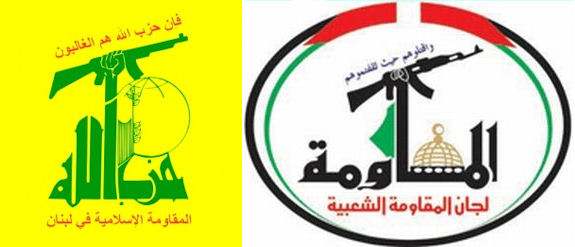
Left: The Hezbollah insignia: The globe represents the organization's global aspirations, and the book represents the Qur'an. The inscription is from the fifth Surah of the Qur'an, Al-Ma'idah, verse 56: "And whoever is an ally of Allah and His Messenger and those who have believed - indeed, the party of Allah (Hezbollah) - they will be the predominant." Right: The PRC insignia: The inscription above the rifle is from the second Surah, Al-Baqarah, verse 191: "And kill them (the infidels) wherever you overtake them." Extremist Islamic organizations and networks, such as Al-Qaeda, often quote the verse to justify the killing of non-Muslims ("infidel").
The Split Within the PRC
After a short period of time the organization cut its ties with Fatah and became an independent terrorist organization. In 2006, at the height of its activity against Israel, the organization received a blow when two of its leaders were killed: organization leader Abu Yussuf al-Qoqa was killed on March 31, 2006, by when a car next to him exploded, and Jamal Abu Samhadana, his heir, was killed when the Israeli Air Force attacked a PRC training camp in the southern Gaza Strip on the night of June 8, 2006. To this day both are considered worthy of emulation by both factions, one headed by Kamal al-Nairab (until his death) and the other by Zakaria Dughmush.
The PRC began splintering in 2006 with the deaths of its two leaders:
1) Kamal al-Nairab inherited the leadership of the organization from Jamal Abu Samhadana and became head of the main faction. The faction has a military wing called the Al-Nasser Salah al-Din Brigades, which collaborates with Hamas. According to its public statements, it also has a central headquarters and various units, including a rocket unit and an engineering unit. It also has a propaganda unit (socalled Jihadist Information) and a wing active in the universities in the Gaza Strip (the so-called Student Resistance Bloc).[4]

Insignia of the Al-Nasser Salah al-Din Brigades, the military wing of the al-Nairab faction. The same Qur'an verse appears: "And kill them (the infidels) wherever you overtake them." Salah al-Din, i.e., Saladin, took Jerusalem from the Crusaders, and his name is used as a symbolic representation of the organization's Islamist jihadist ideology.
2) Zakaria Dughmush, scion of a very powerful Gaza Strip clan, established a splinter faction also called the Popular Resistance Committees whose military wing is the Al-Nasser Salah al-Din Battalions. The faction recently participated in a conference held in Egypt in support of the “resistance” [i.e., terrorism], as did representatives from both Hamas and Hezbollah (see below).
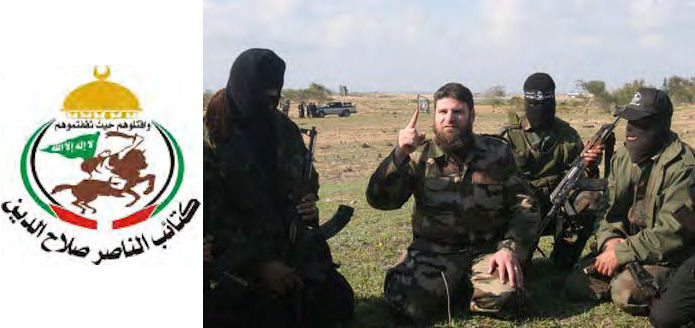
Left: Insignia of the Al-Nasser Salah al-Din Battalions, almost identical to the insignia of the Al-Nasser Salah al-Din Brigades insignia. Right: Zakaria Dughmush, center, surrounded by masked operatives (Photo from the milad.ps website).
3) Mumtaz Dughmush, formerly an operative in the Palestinian Authority’s preventive security force and later a Hamas operative, established the Army of Islam, a network affiliated with the global jihad, and chose an independent path, different from the other two splinter factions. In June 2006 the organization participated in the abduction of Gilad Shalit in collaboration with Hamas and the Kamal al-Nairab faction. The organization was also involved in the abduction of the British journalist Alan Johnston in March 2006. Following Johnston’s abduction a quarrel broke out between the Army of Islam and Hamas leading to a violent confrontation, and the Army was forced to release Johnston. The Army of Islam was also responsible for the abduction of two Fox News correspondents and for dozens of killings carried out to settle internal Palestinian scores. Today the Army of Islam is a large organization, dominant among the global jihad networks in the Gaza Strip, and with much better operational capabilities than the others.
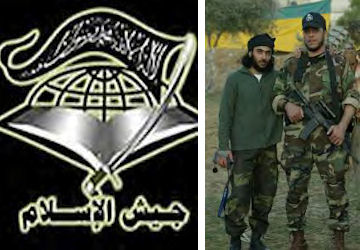
Left: Insignia of the Army of Islam. Right: Mumtaz Dughmush (right), with one of his operatives (Picture from the Hamas website, January 21, 2007).
The Involvement of Hamas and the PRC in Anti-Israeli Terrorist Activities Carried Out from the Sinai Peninsula, 2009-2011
The PRC terrorist attack north of Eilat was not the first of its kind. An analysis of the modus operandi used by the various PRC factions over the years reveals that they have often tried to attack Israel from the Sinai Peninsula, repeatedly violating Egyptian sovereignty, both before and after Operation Cast Lead.
The indirect route from the Gaza Strip to Israel became more important after Operation Cast Lead for Hamas, the Popular Resistance Committees and the Army of Islam. That was mainly the result of the policy of restraint usually enforced by Hamas in the Gaza Strip. That made it difficult for the terrorist organizations to carry out day-to-day attacks against Israel. As a result, after Operation Cast Lead the Sinai Peninsula became a highway for the terrorist squads of Hamas, the PRC and the Army of Islam, all of which tried to infiltrate Israel to carry out various types of terrorist attacks. The organizations were careful not to take public responsibility for the attacks, fearing repercussions from the Egyptian authorities.
The following are instances of the use made of the Sinai Peninsula as an indirect route from the Gaza Strip to Israel by Hamas and the PRC after Operation Cast Lead:
1) December 12, 2009: During a routine security activity an IDF force detained Salman Abu Atiq a Hamas operative, and four other participants, who infiltrated Israeli territory from the Gaza Strip through Egypt. In their possession they had $15,000 in counterfeit money. A search of the area in which they were caught revealed a silencer. During interrogation he said that he had tried to enter Israel to abduct and kill an Israeli soldier, and use his body as a bargaining chip. He also revealed information about Ibrahim Zuara, another Hamas operative from Beit Lahia (northern Gaza Strip), who was detained on December 31, 2009. Two IEDs were found in his possession, weighing between 6 and 7 kilograms each(13.2 and 15.4 pounds, respectively) and a detonator. During interrogation he admitted that he was supposed to place the IEDs in a crowded location in Israel within ten days of his arrival. He also admitted that he was supposed to help Salman Abu Atiq, whom he knew, to abduct and kill an Israeli soldier.
2) June 1, 2009: The Israeli Security Agency and the Israel Police detained Abd al-Rahman bin Khalil Talalqa, born in 1984, a resident of the Nuseirat refugee camp in the central Gaza Strip and a PRC operative. Abd al-Rahman infiltrated into Israel from the Gaza Strip through the Sinai Peninsula to establish a network of terrorist operatives in Israel and carry out various types of terrorist attacks. During interrogation he described the training he had received from PRC operatives in the southern Gaza Strip, including shooting various types of firearms, manufacturing chemical substances used in the production of explosives and IEDs, rigging car bombs, preparing explosive belts and bags, detonating IEDs, using a GPS, map reading and orientation on the ground for purposes of collecting information.
Army of Islam Activity in the Sinai Peninsula
The Army of Islam’s terrorist activity carried out from Egyptian territory has not been limited to border-crossing attacks against Israel. The Egyptian interior minister (until the Mubarak regime was overthrown) and (at his prompting) the Egyptian media accused the Army of Islam operating in the Gaza Strip of involvement in a mass-casualty suicide bombing attack in a Coptic church in Alexandria (in January 2011; 25 dead and scores wounded). Army of Islam operatives in the Gaza Strip were accused of directing terrorist activities in Egypt for Al-Qaeda and for maintaining contacts with terrorist operatives via the tunnels under the Egyptian-Gaza Strip border (called a threat to Egypt’s national security by the former interior minister). The Army of Islam was also accused of involvement in other terrorist attacks carried out in Egypt in recent years, including the attack in the Al-Khalili market in Cairo, in which a French woman tourist was killed, February 22, 2009.[5]
In November 2010 an Army of Islam plan to abduct Israelis vacationing in the Sinai Peninsula was foiled after three of its central operatives were killed in an Israeli Air Force strike in the northern Gaza Strip. On October 17 two operatives who were involved in planning the attack were killed. On November 3 Israeli aircraft attacked the car carrying Mahmoud al-Nimnim, a high-ranking Army of Islam operative, killing him. Al-Nimnim, a resident of the Shati refugee camp, was involved in carrying out terrorist attacks in the Gaza Strip and planned attacks on Israeli and American targets in the Sinai Peninsula in collaboration with Hamas elements in the Gaza Strip (Tsahi Biran, IDF Spokesman’s website, November 3, 2010).
Hamas Involvement in Rocket Fire Targeting Eilat
Hamas was involved in two instances of rocket fire targeting Eilat during 2010:
1) April 22: Three 122mm standard Grad rockets were fired at Eilat and Aqaba from the Sinai Peninsula. One fell in the sea south of Eilat and another hit the neighboring Jordanian city of Aqaba. On April 24 divers found the third rocket on the floor of the Red Sea (IDF Spokesman, April 24, 2010).
2) August 2: Six 122mm standard Grad rockets were fired at Israel from the Sinai Peninsula. Three fell in Eilat, one of them in a drainage pool located to the north of the city. There were no casualties. Two rockets struck the Jordanian city of Aqaba in front of the Intercontinental Hotel. A Jordanian civilian was killed and five were wounded, one of them critically. The sixth rocket fell into the sea.
Behind both attacks was a squad of operatives from Hamas’ military wing, the Izz al-Din al-Qassam Brigades. In neither instance did Hamas admit responsibility for the rocket fire, and on August 2 even denied that the attack had taken place. Its intention was to lower its profile and reduce damages in dealing with Egypt and Jordan, which regarded the incident as an attack on their national security and economies.[6]
Various Types of Terrorist Attacks Carried Out by the PRC, 2009-2011
After Operation Cast Lead Hamas instituted a policy of restraint in its confrontations with Israel, especially to make it possible to rebuild the Gaza Strip and upgrade its military capabilities, a process which so far is incomplete.[7] Hamas occasionally carries out terrorist attacks by itself or through proxies, keeping a low signature, balancing its desires to prevent escalation on the one hand and exhaust the Israeli public on the other. As a result, its security forces enforced the policy on the various terrorist organizations operating in the Gaza Strip. However, they undertook low-key preventive operations against the PRC, using methods more friendly than those used against the other organizations. In most cases PRC operatives have been released immediately after detention. In other cases they have handled by Hamas as proxies.
The following are some of the more prominent attacks and attempted attacks in which PRC operatives were involved since Operation Cast Lead:
1) July 30, 2010: A 122 Grad rocket fell in the southern city of Ashqelon; one civilian was treated for shock. It was the first standard rocket fired since the beginning of 2009. The PRC claimed responsibility (Chinese News Agency, July 30, 2010).
2) July 23, 2009: Light arms were used to shoot at a group of Israelis involved in civilian activities near the Sufa crossing. There were no casualties. After the incident an IDF force patrolling the area was shot at. One of the PRC factions claimed responsibility (PRC website, July 23, 2009).
3) March 1, 2010: An anti-tank missile was fired at an IDF force engaged in a search in the area of the security fence near Beit Lahia (northern Gaza Strip). There were no casualties. The PRC claimed responsibility (Muqawamah website, March 2, 2010).
4) January 1, 2010: Four mortar shells were fired at the Kerem Shalom crossing and a rocket was fired into the western Negev. One of the PRC factions claimed responsibility (PRC website, January 1, 2010).
5) July 5, 2009: Three mortar shells were fired at an IDF patrol near the Sufa crossing. The PRC claimed responsibility (Kawm website, July 5, 2009).
6) July 21, 2009: An IDF force on a routing patrol found four IEDs which had been placed along the security fence near Kissufim (southern Gaza Strip). While they were defusing the IEDs two mortar shells were fired at them and they were attacked with light arms as well. There were no casualties. A PRC faction claimed responsibility (Qudsnet website, June 22, 2009).
7) May 21, 2010: During a routine patrol near the security fence in the southern Gaza Strip an IDF patrol scout was seriously wounded by sniper fire. The PRC claimed responsibility (PRC website, May 21, 2010.
Development of the PRC’s Military Capabilities since Operation Cast Lead
The PRC, like the other terrorist organizations operating in the Gaza Strip, has made a concerted effort to rebuild the infrastructures damaged during Operation Cast Lead. The organization’s factions continue to develop their independent capabilities of manufacturing rockets and conducting training as they carry out attacks against Israel.
The fact that the PRC claimed responsibility for the latest escalation suggests that it can develop and/or acquire the long-range rocket launching capabilities. For example, the PRC claimed responsibility for the Grad rocket attacks on Beersheba, the Grad and improved Nasser-3 rockets used to target Ashqelon and the Grad rocket attack on the southern town of Netivot.
Pictures of PRC military and propaganda activity

An Al-Arabiya TV correspondent reports on a PRC drill simulating the abduction of an Israeli soldier (Al-Arabiya TV, February 2, 2009)

Left: Using RPGs (Picture from the organization website, qaweim.com). Right: The PRC marches in Gaza in support of the so-called Freedom Flotilla (the violent Mavi Marmara flotilla) - (Mofa.ps website)

Left: Training with live weapons (Picture from the PRC website). Right: Firing a machine gun (Picture from the PRC website).
PRC Activity from the Gaza Strip before Operation Cast Lead
Before Operation Cast Lead the PRC’s rocket fire policy was not influenced by political considerations because there were no constraints on the organization, unlike Hamas, and most of their considerations were operational and/or local. In general, the organization integrated well into Hamas’ terrorist policy of maintaining a steady stream of rocket fire into Israel, and its operatives routinely fired rockets, especially in collaboration with other organizations.
In addition to rocket fire, the PRC focused on trying to carry out showcase attacks against Israeli targets at the crossings and around the Gaza Strip.[8] They carried out a particularly large number of attacks in 2006, with some operational successes, the most striking of which was the abduction of IDF soldier Gilad Shalit. The following are some of the attacks either carried out by the PRC themselves or in collaboration with other terrorist organizations:
1) November 28, 2008: During the afternoon an IDF force identified suspicious figures apparently placing an IED near the security fence near Khan Yunis in the southern Gaza Strip. A firefight developed between the IDF force and the terrorist operatives. The IDF shot and killed a PRC operative and wounded four others. In response, at 1500 hours on November 28, the terrorist organizations launched a massive barrage of 17 mortar shells at the Nahal Oz region in the northern Gaza Strip. One rocket was fired, which fell in an empty area. Hamas claimed responsibility for most of the attacks (Izz al-Din al-Qassam Brigades website, November 29, 2008). One of the mortar shells hit an IDF base located in the region wounding eight soldiers, one of them critically.
2) April 9, 2008: During the afternoon a four-man squad of armed PRC operatives broke through the security fence in the northern Gaza Strip. They went to the Nahal Oz fuel terminal and shot at Israeli civilians working there, killing two. The PRC claimed responsibility for the attack, as did the Palestinian Islamic Jihad and Fatah’s Al-Aqsa Martyrs’ Brigade. Hamas’ military wing assisted by firing mortar shells at the IDF forces who pursued the terrorist operatives, but did not actually take part in the attack. Hamas’ Izz al-Din al-Qassam Brigades claimed responsibility for firing 43 mortar shells following what it called “the brave action taken by the factions of the Palestinian resistance at Nahal Oz” (Izz al-Din al-Qassam Brigades announcement, April 9, 2008).
3) June 25, 2006: The PRC participated in the attack against the IDF post at Kerem Shalom by tunneling into Israeli territory. During the attack IDF soldier Gilad Shalit was abducted. Hamas participated in the attack (and later became and still is responsible for Gilad Shalit’s captivity) as did two PRC factions (Kamal al-Nairab and the Army of Islam). Kamal al-Nairab and an operative named Imad Hamad, who were killed in an IDF attack on August 18, 2011, were involved in the abduction of Gilad Shalit.
4) May 29, 2009: Three PRC terrorist operatives attempted to infiltrate Israel from the northern Gaza Strip by placing a ladder against the security fence. The IDF fired anti-tank weapons, killing one of them. The PRC squad was operating in collaboration with Hamas and the Palestinian Islamic Jihad.
5) April 26, 2006: The PRC attempted to carry out an attack at the Karni crossing with a car bomb and by shooting. The attempt, which was prevented by Palestinian preventive security, was directed by high-ranking Hamas operatives in the Gaza Strip, among them Ahmed Jaabari, and Ahmed Ghandour, two heads of Hamas’ military terrorist wing in the Gaza Strip.

Left: The Palestinian side of the Karni crossing (Photo courtesy of Israel Channel 10 TV, 2006). Right: Five barrels of explosives from the car which was supposed to explode at the Karni crossing (Photo courtesy of Israel Channel 10 TV, April 26, 2006).
6) February 1, 2006: Two PRC terrorist operatives attempted to carry out a suicide bombing attack at the Erez crossing (northern Gaza Strip). The sudden drop in the number of Palestinian workers at the crossing raised the suspicions of the officer in charge of the crossing. A short time later two armed operatives were killed by crossing security guards. They were found to be wearing explosive belts.
During 2006 the PRC attempted to develop a terrorist network in Judea and Samaria directed from the Gaza Strip. Its successes were limited. The most conspicuous action in which it was involved was the abduction and murder of Eliahu Pinhas Oshri, shot to death by a Fatah-Tanzim squad directed by the PRC in the Gaza Strip (June 25, 2006).
PRC Attempts to Launch Terrorist Attacks from the Sinai Peninsula before Operation Cast Lead
During 2006 the PRC attempted attacks by leaving the Gaza Strip for the Sinai Peninsula and crossing the Israeli-Egyptian border. Among the attempts were the following:
1) July 21, 2006: A PRC operative was detained near the Israeli-Egyptian border while trying to infiltrate into Israel from the Sinai Peninsula. During interrogation he admitted having been sent to Israel by a PRC operative in the Gaza Strip to abduct an Israeli and smuggle him into the Gaza Strip, to be used to negotiate for the release of Palestinian prisoners. According to the instructions he received, he was supposed to abduct an IDF soldier, and failing that, to kill him and take his documents to the Gaza Strip as the basis for negotiations.
2) June 11, 2006: Two PRC terrorist operatives were detained trying to infiltrate into Israel via Egypt. During interrogation they admitted they had been sent to Israel to abduct and kill Israelis.
PRC Collaboration with Hamas
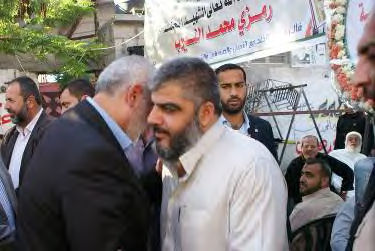
Kamal al-Nairab, PRC leader killed in an Israeli Air Force strike after the terrorist attacks north of Eilat, with Ismail Haniya during a condolence call after the death of one of al-Nairab's relatives (Photo from the Hamas forum, August 20 2011).
For the past several years two of the PRC’s factions, the Brigades and the Battalions, have collaborated closely with Hamas and served as subcontractors for terrorist attacks. The PRC has also operated in conjunction with Hamas, most conspicuously in abducting Gilad Shalit. The third faction, the Army of Islam, found itself confronting Hamas in the past because its affiliation with the global jihad and actions against Western targets were liable to complicate matters for the Hamas administration in the Gaza Strip. The Army of Islam has followed a different route, challenging Hamas.
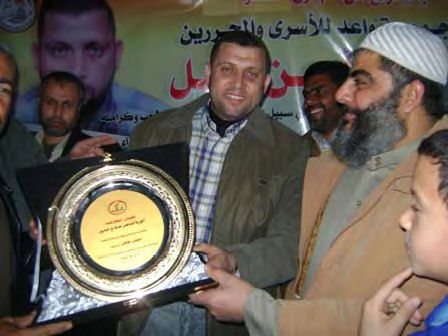
Ayman Nofal, high-ranking commander of Hamas' Izz al-Din al-Qassam Brigades, warmly received by the PRC in the Gaza Strip after his escape from an Egyptian prison (Qaweim.com, February 2010).
In 2006, the PRC’s most active year as a terrorist organization, its collaboration with Hamas increased. The extent of their collaboration was revealed in an interview with Abu Yussuf al-Qoqa, former head of the PRC, posted on the organization’s website after his death. In it he admitted that his organization “coordinated fully” with Hamas, received practical help from the movement, supported it politically and identified with it its Islamic ideology. Hamas’ appointment of Jamal Abu Samhadana, who inherited the leadership of the PRC when al-Qoqa was killed, to the post of inspector general of the interior ministry and police in the Gaza Strip, emphasized the strong connections between Hamas and the PRC.

Headline from the interview with Abu Yussuf al-Qoqa shortly before his death and posted on the PRC website after it. The interview revealed the close operational, ideological and political collaboration between the PRC and Hamas, while claiming that his organization maintained its independence (Moqawamah.com website, April 25, 2006).
Hamas did not denounce the organization which carried out the series of terrorist attacks near Eilat. Hamas spokesman Taher al-Nunu denied all connection between the Gaza Strip and the attacks (Safa News Agency, August 18, 2011). As usual, the Hamas media put the emphasis on denouncing the killing of the high-ranking PRC figures and the deaths of uninvolved civilians in the Israeli attacks. The Hamas media also attempted to incite popular Egyptian sentiments by quoting Egyptian spokesmen who claimed that the Israeli fire had been aimed at Egyptians, and by giving extensive coverage to the demonstrations in front of the Israeli embassy in Cairo.
Participation of the Zakaria Dughmush Faction in the Egyptian Conference in Support of the “Option of Resistance” [i.e., Terrorism]9
On July 24-25, 2011, a conference was held at the Egyptian Press Syndicate in Cairo called the “Founding Conference of the Arab-Islamic Gathering to Support the Option of Resistance” [i.e., the path of terrorism]. It was attended by representatives from 14 Arab-Muslim states, among the Egypt, Saudi Arabia, Syria, Lebanon, Sudan, Tunisia, Morocco, “Palestine,” Turkey, Iran and Indonesia. There were also representatives from Hezbollah, Hamas and other Palestinian terrorist organizations, and a representative from the so-called “resistance” in Iraq. The influence of the Muslim Brotherhood and other radical Islamic elements could also be felt.
The conference was attended by Zakaria Dughmush, head of one of the PRC factions, apparently under Hamas aegis. He attended as head of his own faction, called the Popular Resistance Movement. Representatives from the faction distributed propaganda (publications, documentary videos, songs) glorifying the activities of the Al-Nasser Salah al-Din Battalions, the faction’s military-terrorist wing.
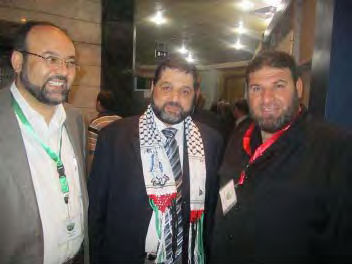
The conference in Cairo: Usama Hamdan, responsible for Hamas' international relations at the Hamas headquarters in Damascus, center. Ali Barakeh, Hamas representative in Lebanon, left. Zakaria Dughmush, head of the PRC, right. (Picture from the PRC website, July 24, 2011).
Notes:
[1] http://www.pmo.gov.il/PMOEng/Communication/Spokesman/2011/08/spoketguva180811.htm
[2] For further information about the attack north of Eilat and the escalation, see this week’s update.
[3] This time as well, the PRC denied responsibility for the attacks. However, according to a description given by a surfer on a Hamas forum (August 21, 01:24 in the morning), there were indications that Kamal al-Nairab felt he had become a target after the attacks near Eilat. According to the site, two hours before he met with other operatives in Rafah for consultations about “the Israeli threats,” he washed, prayed, packed a bag with clothing, documents and personal items and told his wife that “a lot of blood is going to be shed, I am going to into hiding.”
[4] Qaweim.com
[5] For further information about the Army of Islam, see the February 8, 2011 article (ITIC) “Islamic Jihadi Groups May Try to Exploit Egypt’s Turmoil“.
[6] For further information see the date bulletin “Terrorism from the Gaza Strip since Operation Cast Lead: Data, Types and Trends” at http://www.terrorism-info.org.il/malam_multimedia/English/eng_n/pdf/ipc_e169.pdf.
[7] Ibid.
[8] The PRC repeatedly attacked the crossings despite the fact that attacks there only harmed the Gazan population, since the attacks led to their closure. The crossings are the Gaza Strip’s lifeline, and through them enter merchandise, food, drugs and raw materials. That did not prevent the PRC from staging a demonstration in favor of the Mavi Marmara flotilla, which came with the declared objective of breaking the so-called “Israeli siege” of the Gaza Strip.
[9] For further information see the August 13, 2011 article (ITIC) “Egypt: anti-Israel and pro-Terrorism Conference held in Cairo“.



 RSS
RSS




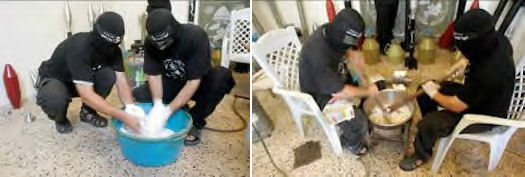
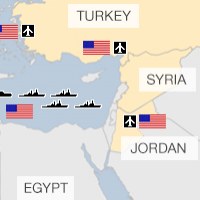
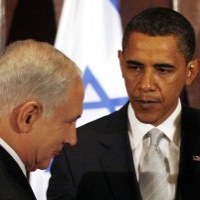
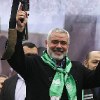






Palestinian Terrorism: Portrait of the Popular Resistance Committees | Middle East news, articles, o http://t.co/WcWdB3I
Palestinian Terrorism: Portrait of the Popular Resistance Committees | Middle East news, articles, o http://t.co/WcWdB3I